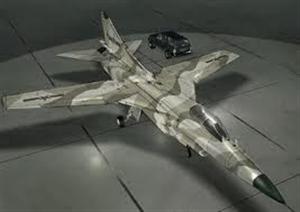Nanchang Q-6
The Nanchang Q-6 looked like a curious combination of two different aircraft from both sides of the ‘Iron Curtain’. The centre/rear fuselage, wings and tail unit were borrowed wholesale from the MiG-23 (except that the tip of the fin was cropped horizontally, not raked).
So were the main landing gear units featuring an ingenious double-hinged design that allowed them to fold inward into a remarkably small space while leaving the fuselage centreline free for long external stores.
The forward fuselage, on the other hand, bore a striking similarity to the General Dynamics F-16A Fighting Falcon; instead of two-dimensional lateral intakes with splitter plates the engine breathed through a single intake of quasi-elliptical section positioned below the single-seat cockpit.Similarly, the nose gear unit located further aft had a single wheel instead of two (it is not clear whether the wheel was to lie horizontally when retracted), and the large radome had an elliptical cross-section with the longer axis horizontal. Unlike the F-16, the cockpit canopy, though similar in shape, consisted of two sections with a fixed wraparound windshield.
 Several powerplants were proposed. In addition to the WS-6 turbofan (selected as the No. 1 choice to power the Nanchang Q-6), the designers considered the WS-9 turbofan or a reverse- engineered version of the Khachaturov R29- 300 afterburning turbojet. The latter engine powering the MiG-23MS was rated at 8,300 kgp (18,300 Ibst) dry and 12,500 kgp (27,563 Ibst) in full afterburner.
Several powerplants were proposed. In addition to the WS-6 turbofan (selected as the No. 1 choice to power the Nanchang Q-6), the designers considered the WS-9 turbofan or a reverse- engineered version of the Khachaturov R29- 300 afterburning turbojet. The latter engine powering the MiG-23MS was rated at 8,300 kgp (18,300 Ibst) dry and 12,500 kgp (27,563 Ibst) in full afterburner.
The Nanchang Q-6 project underwent changes in the course of development. The latest version dispensed with the folding ventral fin but introduced a dogtooth on the stabilator leading edge, and the stabilator tips were parallel to the fuselage axis, not raked. There were three external stores hardpoints under each wing – two under the fixed wing glove and one under the outer wing panel; the inboard and centre ones could carry tandem stores, while the outer wing pylons were plumbed for carrying drop tanks (albeit possibly with the wings at minimum sweep only).
The Nanchang Q-6 was to feature very advanced avionics by the day’s standards, including a powerful navigation/attack radar with a terrain-following feature and an electronic flight instrumentation system. The weapons were to include laser-guided bombs of up to 500 kg (1,102 lb) aimed by means of a laser designator pod.
However, once again the designers encountered major development problems with the Q-6. The efforts to develop a sufficiently reliable wing sweep change mechanism were unsuccessful, and an attempt to copy the Soviet original from the MiG-23 produced a unit that was some 12% overweight, with an attendant reduction in the aircraft’s payload and range. Worse, the development of the WS-6 turbofan was extremely protracted (eventually the engine never reached production).
 As if that weren’t enough, the Chinese military altered the specific operational requirement, demanding an even greater payload and even longer range. Another new requirement was a better defensive capability (reflecting the fact that the Soviet Union had bolstered its anti-aircraft defences along the Chinese border).
As if that weren’t enough, the Chinese military altered the specific operational requirement, demanding an even greater payload and even longer range. Another new requirement was a better defensive capability (reflecting the fact that the Soviet Union had bolstered its anti-aircraft defences along the Chinese border).
According to some sources, by 1983 the original Nanchang Q-6 project based on the MiG-23 had given place to what was in effect a new aircraft built around a new WS-6G engine delivering up to 14,100 kgp (31,090 Ibst) in full afterburner. Yet eventually the Chinese military cancelled the Nanchang Q-6 in favour of the competing JH-7, which was based on more conventional technologies and offered less of a technical risk.

Comments are closed, but trackbacks and pingbacks are open.